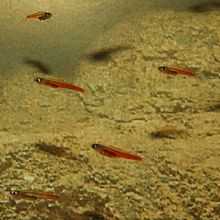Paedocypris
| Paedocypris | |
|---|---|
 | |
| P. progenetica | |
| Scientific classification | |
| Kingdom: | Animalia |
| Phylum: | Chordata |
| Class: | Actinopterygii |
| Order: | Cypriniformes |
| Family: | Cyprinidae |
| Subfamily: | Danioninae |
| Genus: | Paedocypris Kottelat, Britz, H. H. Tan & K. E. Witte, 2006 |
| Type species | |
| Paedocypris progenetica Kottelat, Britz, H. H. Tan & K. E. Witte, 2006 | |
Paedocypris is a genus of cyprinid fish found in Southeast Asia, where it occurs in the Philippines, Malaysia, and Indonesia.
Paedocypris progenetica has been claimed to be the smallest known species of fish in the world. The smallest mature female measured 7.9 mm and the largest known individual 10.3 mm.
Species
The three currently recognized species in this genus are:[1]
- Paedocypris carbunculus Britz & Kottelat, 2008[2]
- Paedocypris micromegethes Kottelat, Britz, H. H. Tan & K. E. Witte, 2006[3]
- Paedocypris progenetica Kottelat, Britz, H. H. Tan & K. E. Witte, 2006[3]
Taxonomy
Two species were discovered and identified by ichthyologists Maurice Kottelat from Switzerland and Tan Heok Hui from the Raffles Museum of Biodiversity Research and the National University of Singapore in 1996.[3] Their osteology was studied by Ralf Britz at London's Natural History Museum. In 1994, the same ichthyologists had already discovered in Sarawak (Malaysian part of Borneo) another miniature species of the same genus Paedocypris. Like P. progenetica, P. micromegethes was found in the slow-flowing blackwater streams and peat swamps.
The genus, Paedocyrpis, and two species, Paedocypris progenetica and Paedocypris micromegethes, were first described in 2006. Paideios is Greek for children and cypris is Greek for Venus and is a common suffix for cyprinid genera; the gender is feminine. Progenetica (from the word progenetic) is used as an adjective. Micromegethes is Greek for small in size, and is used as a noun in apposition.[3]
Paedocypris is considered a danionin genus by Tyson Roberts.[4] Sundadanio and Paedocypris were found to share a sister group relationship, supporting its close relationship to danionin genera; however, this study included danionins among the subfamily Rasborinae.[5]
Appearance
Their miniature transparent bodies lack the typical features characteristic of adult fish, for instance a bony skull structure around its brain, and it retains the postanal larval fin-fold along the ventral edge of the caudal peduncle, characteristic of fish larvae. They have a unique sexual dimorphism: The males have highly modified pelvic fins, with the first ray terminating with a hook-like projection of keratinized skin, supported by hypertrophied pelvic musculature. Males also have a pad of keratinized skin in front of the pelvic fins. These modified fins are thought to be used to grasp the female during mating, or to keep position over a spawning surface.
Smallest vertebrate
Paedocypris progenetica has been claimed to be the smallest known species of fish and vertebrate in the world, particularly before the description of the frog Paedophryne amauensis in 2012.[6] The smallest mature P. progenetica female is only 7.9 mm (.31 in) standard length, smaller than the female of any other vertebrate species, including those of P. amauensis. The largest known individual is 10.3 mm (.41 in).[3]
Male individuals of the species anglerfish Photocorynus spiniceps have been documented to be 6.2-7.3 mm at maturity, and thus claimed to be a smaller species. However, these survive only by sexual parasitism,[7] and the female individuals reach the significantly larger size of 50.5 mm.[8]
Habitat and conservation
Paedocypris progenetica lives in the dark-colored peat swamps of the Indonesian island of Sumatra.[3]
Paedocypris micromegethes lives in the peat swamps of Sarawak (Borneo). Their small size helps them to survive extreme droughts, as they can live in small remaining puddles of acid water (pH as low as 2.9, at least 100 times more acidic than rainwater). Their habitat is threatened by forest fires, logging, and plantations.
References
- ↑ Froese, Rainer, and Daniel Pauly, eds. (2013). Species of Paedocypris in FishBase. February 2013 version.
- ↑ Kottelat, Maurice; Britz, Ralf (2008). "Paedocypris carbunculus, a new species from Borneo (Teleostei: Cypriniformes: Cyprinidae)". Raffles Bulletin of Zoology (National University of Singapore) 56 (2): 415–422. Retrieved 26 October 2012.
- ↑ 3.0 3.1 3.2 3.3 3.4 3.5 Kottelat, Maurice; Britz, Ralf; Heok Hui, Tan; Witte, Kai-Erik (2005). "Paedocypris, a new genus of Southeast Asian cyprinid fish with a remarkable sexual dimorphism, comprises the world’s smallest vertebrate". Proceedings of the Royal Society B (The Royal Society) 273: 895–899. doi:10.1098/rspb.2005.3419. Retrieved 26 October 2012.
- ↑ Roberts, T. R. (2007). "The "Celestial pearl danio", a new genus and species of colourful minute cyprinid fish from Myanmar (Pisces: Cypriniformes)" (PDF). Raffles Bulletin of Zoology 55 (1): 131–140. Retrieved 2009-06-24.
- ↑ Rüber, Lukas; Kottelat, Maurice; Tan, Heok Hui; Ng, Peter KL; Britz, Ralf (2007). "Evolution of miniaturization and the phylogenetic position of Paedocypris, comprising the world's smallest vertebrate". BMC Evolutionary Biology 7: 1–10. doi:10.1186/1471-2148-7-38. PMC 1838906. PMID 17355618.
- ↑ Rittmeyer, E. N.; Allison, A.; Gründler, M. C.; Thompson, D. K.; Austin, C. C. (2012). "Ecological Guild Evolution and the Discovery of the World's Smallest Vertebrate". In Etges, William J. PLoS ONE 7 (1): e29797. doi:10.1371/journal.pone.0029797. PMC 3256195. PMID 22253785.
- ↑ Sandra Hines, 2006. "Flap over fishes: Who's the smallest of them all?" University of Washington News
- ↑ Raffles Museum news, 2006. "RMBR: So which is the smallest species of fish in the world? (Part II)"
External links
- BBC: Scientists find 'smallest fish'
- BBC: Is it really the smallest fish after all?
- Pharyngula: Paedocypris
- Raffles Museum of Biodiversity Research, National University of Singapore
- Some records in the fish world
| Wikispecies has information related to: Paedocypris |